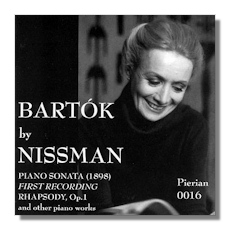
The Internet's Premier Classical Music Source
Related Links
- Bartók Reviews
- Latest Reviews
- More Reviews
-
By Composer
-
Collections
DVD & Blu-ray
Books
Concert Reviews
Articles/Interviews
Software
Audio
Search Amazon
Recommended Links
Site News
 CD Review
CD Review
Béla Bartók

Women in Music, Volume 6
- Sonata (1898)
- Rhapsody, Op. 1 (1904)
- Two Élégies, Op. 8b (1908-1909)
- Four Dirges, Op. 9a (1909-1910)
- Improvisations on Hungarian Peasant Songs, Op. 20 (1920)
Barbara Nissman, piano
Pierian Recording Society 16 73.59 2003
Nissman, whose Prokofiev Piano Sonatas are so impressive, plays Bartók equally well. She begins and ends with very youthful works of his, so much so that one familiar only with the mature Bartók would not recognize them as his: a twenty-four and a half minute Sonata in four movements which he wrote at age seventeen, and his Opus 1 Rhapsody, written six years later in 1904. Nissman, who wrote her own notes for this release, remarks on influence by Schubert and Brahms in the Sonata, as well as on actual quotes from Schubert and Wagner. She also comments that the pianism in the Sonata is Lisztian, as is the Rhapsody as a whole. One might suggest that the Rhapsody is to mature Bartók as Burlesque for Piano and Orchestra (a better work) is to Richard Strauss. I prefer Bartók's Sonata to his Rhapsody, no doubt because I much prefer Schubert to Liszt.
Moving on chronologically, the Élégies and Dirges reflect Bartók's mood of dejection after having been rejected by the young woman he loved, Stefi Geyer (for whom he wrote his first Violin Concerto), on account of their strong disagreements over religion. The Élégies are quite different from the Dirges. Nissman writes of the Élégies that "All of the trappings gleaned from Liszt are in abundance: tremolos, cadenzas, arpeggios, trills, octaves, orchestral sonorities, but Bartók's development of material represents the antithesis of romanticism. Material is developed with leanness and sparseness." In considerable contrast, the brief Dirges sound more like Debussy, and are to some ears may be the most appealing works recorded here.
The eight Improvisations on Hungarian Peasant Songs, one of which is dedicated to the memory of Debussy, are more representative of the mature Bartók, who is so well-known for collecting traditional folk tunes and incorporating much of their style into his own style. They are all very short and they are varied. Rhythms tend to be jagged and attacks fierce. Two of them are marked "molto capriccioso."
Recommended.
Copyright © 2012, R. James Tobin




















